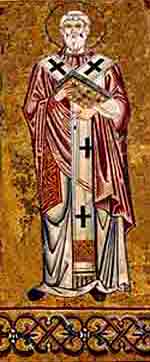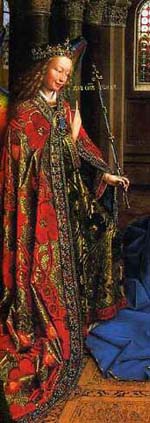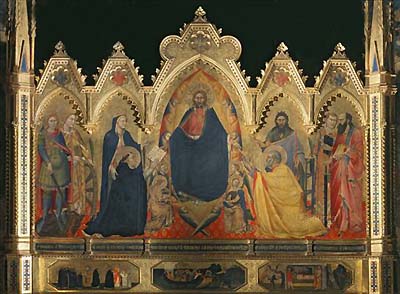 |
The Saint of the Day
St. Peter Chrysologus – December 4
Prof. Plinio Corrêa de Oliveira
Biographical selection:

St. Peter the golden-worded |
St. Peter was born at Imola, Italy in 406. He was formed in science and sanctity there. In 433, Pope Cornelius elevated him to Bishop of Ravenna.
He defended the Catholic Faith against the heretic Eutyches in a letter directed to the Council of Calcedonia (448). He was renowned for his eloquence and earned the title of “Chrysologus,” which means golden worded. After having ruled the Diocese of Ravenna for 18 years, he died in his native city on December 4, 450. His relics are venerated in the Basilica of Ravenna.
This is an excerpt from a sermon by St. Peter Crysologus on the Annunciation:
To the one destined to be the Most Holy Virgin, God sends a winged messenger, an Angel. He is the transporter of grace, and he delivers grace to Our Lady. He states the proposal of the Spouse and receives her answer. He brings back her consent to God, conveying to God the faith of Our Lady, her acquiescence.
The Angel’s presence is a reward for Our Lady’s high virtue. He poses the question of her virginal maternity. In swift flight, the zealous messenger descends from Heaven to the Virgin to suspend the rights of the Spouse, St. Joseph, and without releasing the Virgin from Joseph’s authority, he returns her to the Holy Ghost whose spouse she was from the first instant she was created.
Comments of Prof. Plinio:
St. Peter Chrysologus is using the model of a proposition of marriage. As is the custom in marriages of state, the father asks for the hand of the bride, sometimes through a third party representing him. So, St. Peter applies that same formal ceremonial process to the Annunciation.

God sends St. Gabriel to propose the marriage
Annunciation by Van Eyck
|
God the Father sends a messenger to offer to the bride a proposal of marriage with the Holy Ghost. Our Lady agrees, and the messenger swiftly returns to give the good news to God. The rights of St. Joseph are suspended, but he maintains authority over her, and continues to legally be her recognized spouse.
This common truth that we all know, St. Peter Chrysologus understood how to state in very elevated words, confirming the fame of a man reputed to be golden-worded.
Here, it seems opportune to comment on the great orators of bygone times. Since today we are in the epoch of radio and TV announcers, perhaps we could profit from hearing something about such grand men. Just as there was a period in the Church when she had great Bishops who founded Christendom, she also had a time when great men, the Church Fathers, organized it. They were followed by the Doctors who solidified the Church; there were also great orators in various eras of History.
Those orators left literary pieces recognized as works of art by everyone through the centuries; even pagans and ignorant persons admire those works. In those days, the sermons and homilies of such orators represented the apex of public speaking, the heir of the ancient Greek and Roman oratory richly infused with the Catholic spirit. Those works were so elevated in content and rich of language that they became lasting models for centuries.
We can see how the various gifts and charismas were distributed in the Church. At a time when the Church was still very young and weak, the gifts and charismas were stronger and more widespread, and they remained as monuments of grace for the future.
Hence, we have two men whose titles earned in History indicates the value of their oratory: St. Peter Chrysologus, the golden-worded man, and St. John Chrysostomus (Chrysostom), the man with a golden mouth, that is, everything he said was beautiful in its form and golden in its contents. These are the titles the Church uses until today to celebrate the oratory of those men.
Since these graces were given to the nascent Church to fortify her institution in the first centuries, we may ask if those graces will return or if they have disappeared forever in the Church.

Christ as Redeemer with Our Lady and Saints
by Andrea Orcagna |
I believe that according to the needs of different epochs, the charismas multiplied through the centuries. I also believe that we can expect a great resurrection of all of them to assist the foundation of the Reign of Mary after the fall of our contemporary civilization, as was promised at Fatima. Indeed, after Our Lady announced the chastisement and destruction of many nations, she made a solemn pledge that in the end her Immaculate Heart would triumph.
Therefore, for the establishment of this new era, we can expect a revival of the most magnificent graces of the past, as well as the appearance of never-before-seen graces. For when God gives something to Our Lady, He gives the best, and for the establishment of her triumph in her Reign, He will not spare any privileged grace or extraordinary gift.
As Our Lady was the masterpiece of God among creatures, her Reign will be His masterpiece among civilizations. To achieve this splendor, He will give all that He can.
Therefore, we should pray to Our Lady, through the intercession of St. Peter Chrysologus whose feast day we commemorate, that she give us the firm hope that those graces of the past will return to shine for her glory. The sun that illuminated the first steps of the Church in her dawn will still illuminate her steps in the last and more glorious epoch of her existence, when History will shine with its more majestic lights before its final sunset.


  | | Prof. Plinio Corrêa de Oliveira | |
The Saint of the Day features highlights from the lives of saints based on comments made by the late Prof. Plinio Corrêa de Oliveira. Following the example of St. John Bosco who used to make similar talks for the boys of his College, each evening it was Prof. Plinio’s custom to make a short commentary on the lives of the next day’s saint in a meeting for youth in order to encourage them in the practice of virtue and love for the Catholic Church. TIA thought that its readers could profit from these valuable commentaries.
The texts of both the biographical data and the comments come from personal notes taken by Atila S. Guimarães from 1964 to 1995. Given the fact that the source is a personal notebook, it is possible that at times the biographic notes transcribed here will not rigorously follow the original text read by Prof. Plinio. The commentaries have also been adapted and translated for TIA’s site.
|
Saint of the Day | Home | Books | CDs | Search | Contact Us | Donate

© 2002- Tradition in Action, Inc. All Rights Reserved
|
 |

|